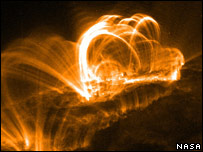If our sun were to explode with such force - there would be no life left on Earth or at best a mass extinction would occur

NASA's Swift satellite observed a massive eruption from a neighboring star in the solar system. Our sun also experiences outbursts when its magnetic field lines collide with each other in the sun's atmosphere, but this is an outburst on a much larger scale, the scientists say.
The energy released from the planet II Pegasi was equivalent to 50 million trillion atomic bombs. They calculated. If the sun were to ever produce an eruption of such intensity it could flood the earth with so much radiation that it would surely cause a mass extinction.
Fortunately, there is no geological evidence that the Sun erupted in these towering masses and Earth's magnetic field does a good job of repelling most of the high-energy particles and radiation from our star from reaching Earth in the normal eruptions.
However, the researchers are interested in learning more about this type of "superbursts" observed by Swift, and thanks to the ability of this space telescope to quickly direct its instruments to cosmic events of interest, it was possible to reveal new data about the X-radiation in the first stages of this violent celestial phenomenon.
